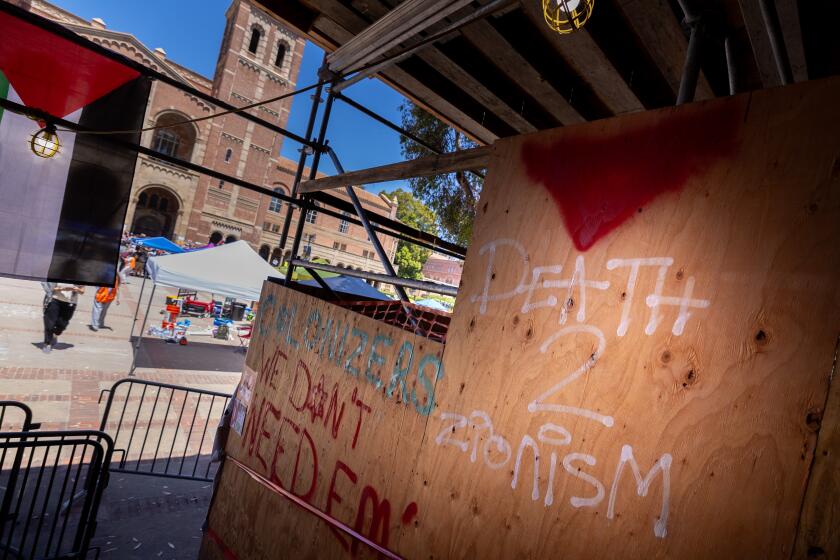A LOOK AHEAD * Educators in seven districts are asking voters to approve $400 million in bonds. Nowhere is the opposition as fierce as in Torrance, where backers for the third time prepare to . . . Battle for School Funds
In a rented office a stone’s throw from picturesque but aging Torrance High School, Mary Taylor spends much of her time these days on painstaking volunteer work. As head of the citizens committee trying to see that voters approve an $80.5-million school renovations bond measure--the Torrance Unified School District’s third try in less than a year--she is coordinating the efforts of an army of parents and other supporters.
Not far away, Rick Marshall and Shawn Moonan also are busy--as leaders of a small band of suburban guerrilla fighters trying to torpedo the bond measure, an aim they achieved with its two predecessors.
The election battle in this usually politically placid South Bay community is one of the hottest of the campaigns for seven school bond measures on local ballots around Los Angeles County on April 14.
In all, voters are being asked to approve almost $400 million in bonds to modernize and expand cramped, aging campuses or to build new schools. All require two-thirds approval, a mark that for some districts, including Torrance, has so far remained out of reach.
Of the seven districts seeking bond approval this month, the Compton Unified School District is asking the most--$107 million to repair its badly neglected schools.
The district has been under state supervision since 1993 because of its academic and financial problems, and the advanced state of disrepair on its campuses--including leaking roofs and unusable restrooms--has angered parents and civil rights groups.
But Compton’s highly charged political atmosphere threatens the bonds campaign. Mayor Omar Bradley is leading the charge to defeat the schools measure because, he said, the school board, relegated by the state takeover to advisory-only status, will have little say in how the funds are spent.
*
On Saturday, Bradley played host to what he called an urgent public forum at City Hall to fan opposition to the school district’s bond measure. Attended by about 50 people, many of them senior citizens worried about an increase in their property taxes, the meeting featured speeches by several elected officials, city commissioners and religious and community leaders opposed to the measure.
They included council members Fred Cressel, Marcine Shaw and Dolores Zurita, Compton Community College District Trustee Carl Robinson and school board member Carol Bradley Jordan, the mayor’s sister. Last month, Jordan was arrested during a school board meeting after she allegedly grabbed the microphone from the state-appointed schools administrator, Randolph E. Ward, as he was about to swear in a new member.
The ballot measures in the other five districts appear to have little or no organized opposition.
Bond measures to finance campus renovations and expansions are becoming regular fixtures on local ballots up and down California, and for several reasons.
Years of tight school budgets have forced many districts to postpone spending for such big-ticket items as new roofs, plumbing and wiring on buildings that are now 30, 40 or 50 years old or more. Moreover, rules for dispensing proceeds from state school bond measures make it all but impossible for a district to get facilities funds from Sacramento unless it has won approval for a bond measure of its own to provide a “local match” of moneys.
In addition, the state’s class-size reduction program, coupled with a growing school-age population, has dramatically increased the need for more classrooms around the state.
In some districts, voters have been willing to approve general obligation bonds earmarked for school facilities. The bonds are sold to investors who are repaid with interest over a set period, usually 25 to 30 years. To pay off the bonds, taxpayers are charged an annual amount based on their property’s assessed value.
*
Last June, voters approved five of the eight local bond measures on ballots in Los Angeles County. The three that failed each garnered more than simple majorities but could not muster the required two-thirds majority.
And in November, voters in four local districts approved school bond measures by margins ranging from 71.5% to 79.3%, but such measures lost in four other districts. Again, all of the losers handily reached beyond the 50% mark but fell short of the two-thirds needed.
In Torrance, the numbers on the two failed efforts are at once frustrating and encouraging to school officials, parents and the city’s political and business leaders who are hoping the third time will be a charm. Measure A pulled 57% of the vote in June; Measure K earned 62% in November.
“We’re certainly encouraged that the numbers went up,” said campaign chairwoman Taylor, a business consultant with two sons attending Richardson Middle School.
“But we have learned we cannot take anything for granted,” Taylor continued. “We have organized opposition, and, with their misleading statements, they can create just enough doubt to keep us from getting to two-thirds.”
Opponents, including Marshall, a twice-unsuccessful candidate for the school board, attend school board meetings or pore over minutes, looking for items they believe will provoke taxpayers. Then, under their organization’s logo SMART (for Save Money with Accountability and Responsible Taxation), they send out news releases and campaign fliers.
The same message underlies them all: The district is squandering money it could be using to refurbish the schools and does not really need to be asking taxpayers to shell out more.
“We think there is potentially a lot of money there,” said SMART spokesman Moonan. “This [bond measure] is the same thing that was rejected by voters twice before. The district needs to do their job and come up with alternatives.”
*
Bond measure supporters say the opposition’s statements are full of errors and that the amounts involved are just a tiny fraction of what is needed to fix the schools. For example, SMART recently said that the district spent $37,000 on an early childhood curriculum conference that it hosted, when in fact the entire cost was reimbursed by other districts that sent teachers. SMART also criticized the district for spending $25,000 on a jobs training program for Samoan students; the funds came from a federal grant available only for such purposes and did not cost the district a dime.
“It appears to be an attempt to mislead” voters, Taylor said of SMART’s tactics, which she said consume a lot of bond measure volunteers’ time in trying to set the record straight.
“It detracts from the basic point: Our schools are 30 to 80 years old. They are not built to sustain 50 years of use without substantial renovations, and the money just has not been there,” Taylor said.
She is also critical of opponents’ failure to file timely reports on who contributes to the campaign and how the money is spent. The county registrar of voters recently fined the group for a late report from a previous bond campaign.
“We don’t have any excuses for it,” said Moonan, who blamed the group’s ex-treasurer. “We admitted the problem and we paid the fine.
“None of this changes the point that we don’t need a [bond measure] to pay for things we should pay for out of the budget.”
Torrance voters have not passed a school bond measure since the 1960s. Taylor, a former PTA president, and the volunteers are hoping to change that.
They are contacting voters through precinct walks and telephones. By mid-March, the campaign had reached about 36,000 of the city’s nearly 75,000 registered voters.
The biggest potential boon is their effort to get sympathetic voters to cast ballots in advance by mail.
In November, there were 21,402 ballots cast in deciding the Torrance bond measure; of those, 4,628 were absentee, or mail-in, ballots, and more than half, 2,773, were “yes” votes.
(BEGIN TEXT OF INFOBOX / INFOGRAPHIC)
School Bond Measures
Voters in seven school districts around Los Angeles County will be asked on April 14 to approve bond measures to repair or expand aging campuses or to build new schools. All measures must win two-thirds of the vote to pass.
*--*
DISTRICT AMOUNT SOUGHT Compton Unified $107 million Duarte Unified $44 million Montebello Unified $92 million Paramount Unified $35 million Temple City Unified $24 million Torrance Unified $80.5 million South Whittier $15 million
*--*
More to Read
Start your day right
Sign up for Essential California for news, features and recommendations from the L.A. Times and beyond in your inbox six days a week.
You may occasionally receive promotional content from the Los Angeles Times.







